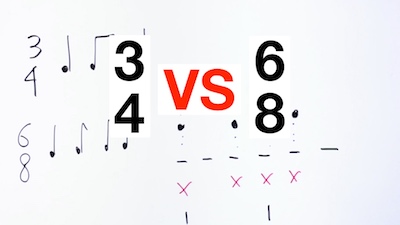6/8 vs 3/4: POLYRHYTHMs From A Time Signature Difference


What is the exact difference between 3/4 and 6/8 in music?
Ok, I have to admit that this is not a particularly exciting question at first sight. After all it takes but a minute or two to explain the difference between these two time signatures.
And it's definitely not life-and-death information either: the worst you can get from picking the wrong one when you write a song is a few scowls from a musician or two.
(And these people will scowl at you even if you notate chords in a way they don't like, or if you use the wrong font in the title of the score - true story!)
But if we go and look a bit beyond the obvious... we see that musicians have actually been leveraging the fact that these two time signatures are similar but different.
If you've been following this newsletter for a while you know that I have little patience for theory that is not useful... I like to 'use' music theory to get ideas for composition, not for armchair music analysis.
By comparing 3/4 and 6/8 not only we get some interesting rhythm... we can see also a few tricks to make 'stale' rhythms sound better (like using polyrhythms... or displacing them!).
So if you have a song that has potential... but it does not have 'groove'... have a look at what I do to these rhythms and you will have some ideas to make that song a crowd pleaser.
There is much more we can do with rhythm! We can see two more things that can give you inspiration for your songs:
- This is how several famous artists have used creative rhythm in the choruses of their songs:
- How to use one of the most common odd time signatures. Includes examples from different music styles, that show you how odd time signatures are not just the exclusive of progressive music:
For all this talk about rhythm, let's not forget that these rhythms work only if you use them with a great chord progression.
To learn how to write a great chord progression - or how to make a bad chord progression sound better - check out the Complete Chord Mastery guitar course because it's awesome.
Did you find this video helpful? Do not miss the next Music Theory videos!
Subscribe to the MusicTheoryForGuitar YouTube channel by clicking the button below.